|
By Colonel Harold (Hal) Austin, USAF (Ret.) Page 3 of 3 pages |
||||||||||||||
| As we coasted out off Norway, it was obvious we had fallen behind the fuel curve. We climbed to 43,000 feet and throttled back to max-range cruise. It did appear however, that we could get to a base in England and we knew there was a strip alert tanker at Mildenhall awaiting our call. My co-Pilot had spent much of the time since the last Migs departed sitting in the aisle acting as the intercom between me and NAV. You just don’t realize how handy the intercom is until you don’t have one in a tandem airplane. |
||||||||||||||
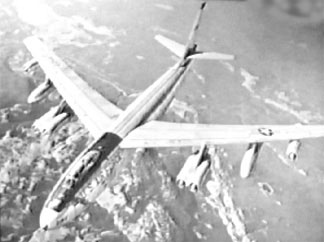 |
||||||||||||||
|
|
||||||||||||||
| Holt was beginning to panic on the fuel as we reached a point about 150 miles from the Wash. He said all this effort was for naught if we have to bail out of the airplane, and left no film for intelligence to process that would prove where we had been. Within about 100 miles of the Wash, I started calling for the stirp alert tanker to launch. Jim Rigley, the tanker pilot, said he heard a word or two, enough to recognize my voice (these were our tanker guys, so we all knew each other.) Anyway, he attempted to get permission to launch. Well, as it sometimes goes, the RAF had an emergency working. Rigley announced that he was launching anyway and did. When he returned to base, the Base Commander threatened him with a court martial and British Air Traffic Control gave him a violation, both situations were later “fixed” by General LeMay. |
||||||||||||||
| In all of my nine years of flying up to that time, I was never more thrilled to see another airplane in the air than I was to see that beautiful KC-97 that day. I saw Rigley’s airplane and headed for it. We had already decided to land if need be at Brize Norton, and were letting down to do just that. Holt said, “We’re going to run out of gas.” Rigley had his guys looking up for us and caught a glimpse of what they thought was our airplane and leveled off at 3,000 feet heading south. I circled once letting down. As we maneuvered and pulled into contact position, Holt said, | ||||||||||||||
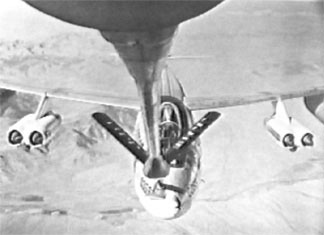 |
||||||||||||||
|
Ctsy. Harold S. Myers Jr. |
||||||||||||||
| “We are taking on fuel.” He swears to this day, all tank gauges showed empty when we made contact. I told Holt to tell me when we had 12,000 pounds of fuel. When he said NOW, I punched the boom loose, gave the Boom Operator a salute and headed for Fairford. We buzzed the tower and as we came around they gave us a green light to land. When we reached the ramp and parked, the crewchief was first up the ladder, “What the hell kind of seagull did you hit?” |
||||||||||||||
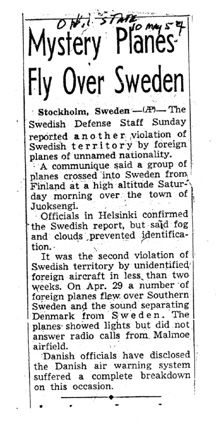 |
||||||||||||||
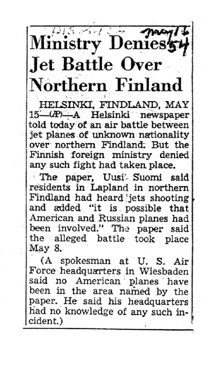 |
||||||||||||||
|
|
||||||||||||||
| If General Curtis E. LeMay was still alive I might have second thoughts on telling about this mission even though its been over 45 years (1954-2000). My crew, Carol Holt, Co-pilot and Vance Heavilin, Navigator, and myself were decorated by General LeMay, then Commander in Chief of the Strategic Air Command, with two DFC’s, each in lieu of the Silver Star for a single RB-47E, visual photo reccy overflight of the Soviet Union. When General LeMay presented our DFC’s he apologized, stating that the recommendation for the Silver Star had to be approved in Washington which could cause two problems; first they’d get the thing screwed up, and; second, and I quote, “I’d have to explain this mission to too damn many people who don’t need to know.” About the Author: Colonel Harold (Hal) R. Austin retired in December 1976 from the USAF with nearly 34 years of military service. He is a command pilot with nearly 10,000 flying hours in 22 different types of military aircraft. Born in Sweetwater, OK, Austin went on to earn a Bachelors Degree from the University of Nebraska at Omaha and later a Masters Degree from George Washington University in Washington DC. He was commissioned as a 2nd Lieutenant in the Army Air Corp. and earned his pilot wings on 15 April, 1945. Hal graduated from Command and Staff school in 1959 and the Air War College, 1966 at maxwell AFB, AL. Military duty has included flying the Berlin Airlift from Frankfurt, Germany; 24 years in the Strategic Air Command as Aircraft Commander; Maintenance Staff Officer; and Commander of the 384th Air Refueling Wing, McConnell, AFB. Austin’s career also included Operations Staff Officer at SAC headquarters and J-3, Office of the Joint Chiefs of Staff at the Pentagon. After retirement from the USAF, Colonel Austin was employed as a stockbroker and later Director of Marketing for a retirement community. He then joined and purchased interest in a long distance telephone company primarily serving California. Very active in his community, Hal is the past president of the Riverside, CA Chapter of the AF Association; member and past chairman of the Riverside Chamber of Commerce Military Affairs Committee; Rotary Club and numerous other civic organizations. Hal has been a Life Member of the Order of Daedalians since 1971. He carries Named Membership #0695, for Founder Member, Don Gilmore, and is a member of 30th Flight (Hap Arnold). |
||||||||||||||
| Comments From the Back Seat: Carol Holt, Co-Pilot It was a clear day (not a cloud in the sky) as we coasted in to the Soviet Union. Suddenly we started to generate contrails like six white arrows pointing to our airplane. (Not in the forecast!) As we passed over our first recon target, I could see the fighters circling up to meet us and knew it would only be a matter of time before they reached our altitude.
|
||||||||||||||
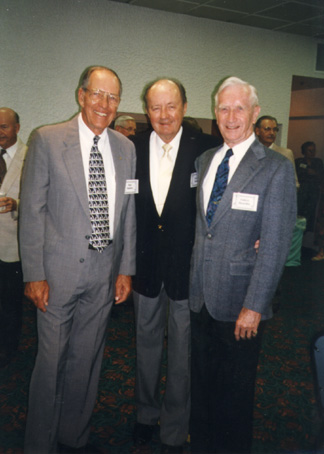 |
||||||||||||||
|
Together again at a reunion in 1995 |
||||||||||||||
| They could only make passes from either side of a greater than 45 degree angle. Later, after we were hit in the left wing and fuselage, one MIG tried to ram us by side slipping his fighter into our aircraft. On one “ramming” pass he stalled out right under our aircraft and our vertical camera took one of the first close-up pictures of the new MIG-17. (The Intelligence community was elated at the picture!) As we coasted out of Finland one of the remaining fighter pilots flew up to our right wing, gave us a salute, and then turned back toward the Soviet Union. Having flown combat in WW2 and later recalled during the Korean War, I thought we were in a Cold War with Russia, not a hot one, since all the Reconnaissance plane “shoot downs” had been kept very secret. During our de-briefing with General LeMay, I said to him, very innocently, “Sir, they were trying to shoot us down!” Smoking his usual long cigar he paused, leaned back and said “What did you think they would do, give you an Ice Cream Cone?” His aids all smiled, but I was serious. End of this story This is page three of a three page document. Click one of the selections below to move on. Home - Contact Us - Cold War Hist. - 91st SRS Hist. - Stardust 40 Mission Story |
||||||||||||||